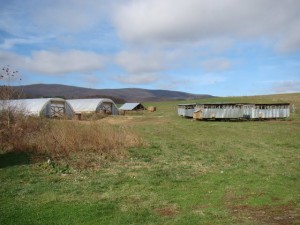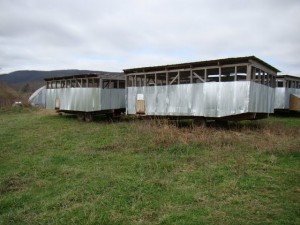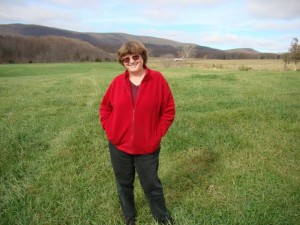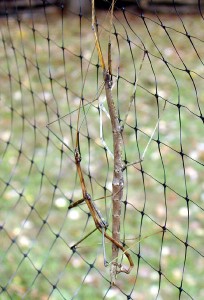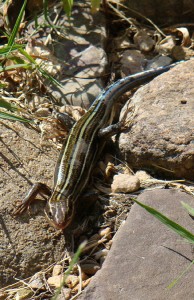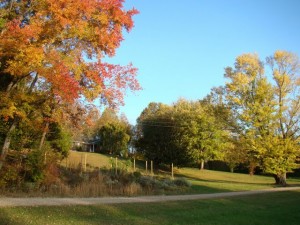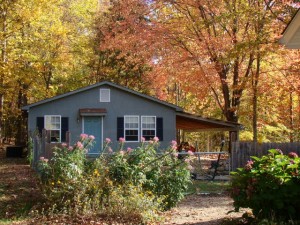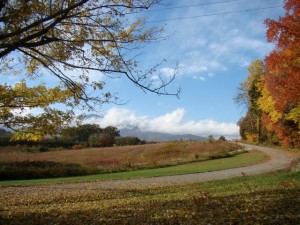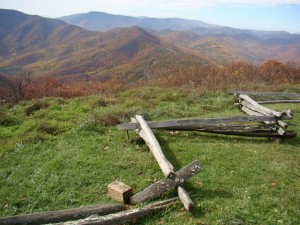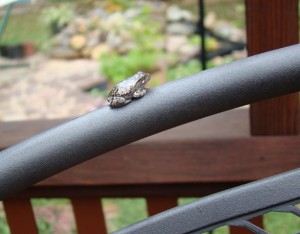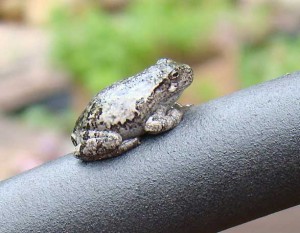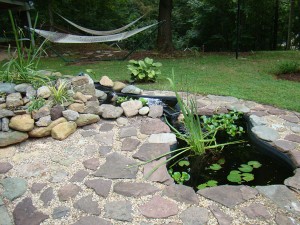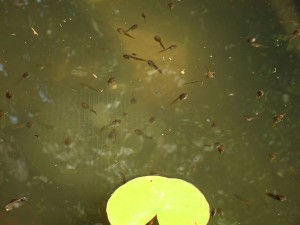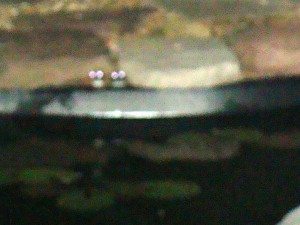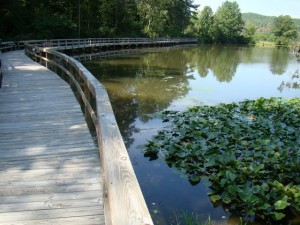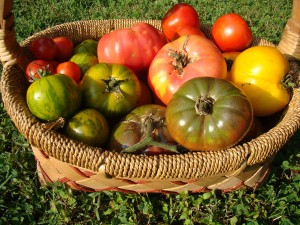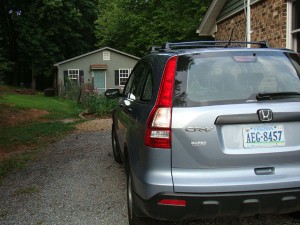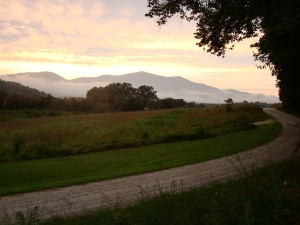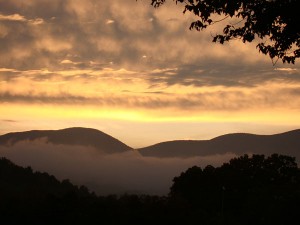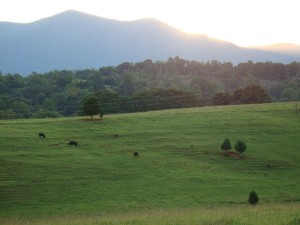Michael Pollan’s The Omnivore’s Dilemma introduced Joel Salatin and Polyface Farm to its many readers, and since then both have acquired iconic status in the emerging sustainable and local food movement. Salatin himself is a prolific writer, and in addition to his various books, he writes an excellent column in Flavor Magazine, and has been featured in the recent films Food Inc and Fresh (these film links include short clips and photos featuring Salatin).  Duly inspired but also anticipating Thanksgiving dinner, Monika and I drove out to Polyface Farm today. It’s a lovely ride over the mountains and across the Shenandoah Valley to get there. Visitors are invited to explore the farm on foot, which we did. It was fun to see the famous eggmobiles (which transport and house hens in sequential feeding grounds). We left with a Thanksgiving turkey, ham, pork chops and chicken parts (including feet!) for chicken stock, which is bubbling away on the stove as I write this post. More pictures of our visit are available here.
Wed 4 Nov 2009
Of Walkingsticks and Skinks
Posted by Bob under Nature
No Comments
Having introduced some of the frogs and toads on our five acre property in previous posts, this post is about two other species that also feel like old friends. My sons and I used to be fascinated at the Insect Zoo of the Smithsonian Natural History Museum in Washington DC by insects generally known as stick bugs or walkingsticks (technically phasmids), which camouflage themselves by looking like sticks or leaves. We generally imagined these to be mostly tropical insects–which is indeed true–but we do appear to have several varieties here in Virginia. Click on the left picture to see the detail of two walking sticks (probably Giant Walkingsticks) mating on the deer netting around our vegetable garden (in contrast to many species, males in the phasmida order are generally considerably smaller than the females). Wild sex in the garden! A new twist on the botany of desire.
Skinks too recall fond memories–my sons and I used to see them at Sunfish Pond along the Appalachian Trail in northern New Jersey. Here we see five-lined skinks practically all the time around our house, pond, and potting shed. They are strikingly handsome creatures, often with deep blue tails, as in the pictures above taken by our little pond. One theory of the almost-neon tails is that they evolved to direct a predator’s attack to a part of the body that is readily severed and replaced.
Skinks are curious creatures, as the pictures taken by Monika below show: here a five-lined skink takes a quick look inside and finds the outdoors more to its liking! (For larger images, click on any image and then Slideshow.)
Mon 26 Oct 2009
Fall Colors: at Home and along the Blue Ridge Parkway
Posted by Bob under Nature, Our New Home
No Comments
So far we haven’t met a season down here we didn’t like, and fall has been characterized by clear days, nice temperatures, and lovely colors. The pictures above show our dirt road and our little forest, our house and vegetable garden on the hill, and our storage cottage (formerly a kennel) in the back. We’ve yet to have a frost, so our spider and other flowers are still in bloom.
While the views and colors at home are pretty spectacular, we’ve taken several rides on and around the Blue Ridge Parkway. In addition to the pictures above and below, others are available by clicking here.
Wed 14 Oct 2009
Pond Post Script
Posted by Bob under Nature
[2] Comments
This little gray tree frog appeared on our back deck last week, confirming that our little pond had successfully spawned not just green frogs, but gray (“common”) tree frogs as well. It was about three-quarters of an inch long and will grow to be about two inches long. (In addition to our observations, much of what we know about the frogs and toads on our property comes from the Stokes Nature Guide on Amphibians and Reptiles , a great book in a great series, which focuses on the life course and ecology of animals and plants.)
Below: a southern toad from a nearby hike in the mountains, which we’ve also seen in our yard. (We’ve seen several large American toads as well.)
Thu 17 Sep 2009
Pond Happenings
Posted by Bob under Nature
No Comments
Our life in Virginia revolves around simple pleasures, such as observing our little pond in the backyard. This is surprising: the little artificial pond was in sorry shape when we moved in, and our first instinct was to tear it out. All that changed in late April when we realized that a green frog had taken up residence there. There was no way the new landlords were going to evict him. But the natural life of the pond has proven to be far more elaborate than we first realized.
A male green frog has been the dominant presence at the pond, but he appears to be visited periodically by females, judging by consecutive waves of tadpoles and the nighttime picture on the right, taken in early July. His banjo-string-sounding croak is heard throughout the day and evening.
Nights after rainy days or evenings produce temporary visitors to the pond. The loud trills of treefrogs are almost ear-splitting, as they gradually come down to the pond searching for mates (the fuzzy middle picture above appears to capture such a moment), producing new batches of tiny tadpoles. By mid-September, no more tadpoles were visible in the pond, but the young frog in the picture on the right was on a swiss chard leaf that I picked and brought into the kitchen.
Fri 11 Sep 2009
Two Recent Pieces by Michael Pollan
Posted by Bob under Farms and Food, Rants
1 Comment
No author has informed and influenced me more in recent years than Michael Pollan. As I became interested in gardening, his Second Nature: A Gardener’s Education captured the tension (also, as Pollan says, a false dichotomy) between nature and culture that is inherent in the enterprise and bedevils every gardener. His Botany of Desire provided, as its subtitle states, “A Plant’s-Eye View of the World,” both putting claims of “domestication” in perspective and showing how dangerously problematic the collaboration of corporate and plant species interest can become. Pollan’s The Omnivore’s Dilemma then integrated these themes into a broader canvass that included a devastating critique of industrial agriculture and a lament for the loss of a coherent food culture in the U.S. And most recently, Pollan critiques the faddish and corporate-influenced nutrition industry in his In Defense of Food: An Eater’s Manifesto, which also includes a vigorous defense of the pleasures of cooking and good eating. I’ve learned much from each of these highly readable books, and recommend them to all.
In the past month or so, Pollan has published two pieces in the New York Times that are perhaps less likely to have caught the eye of readers of this blog: hence this post. The first, Out of the Kitchen, Onto the Couch, is a fascinating analysis of how it has come about that Americans as a whole spend more time watching cooking shows than actually cooking, something that only a decreasing minority actually engages in. This has meant that corporations do the cooking for America, with obesity, diabetes, heart disease, food poisoning, environmental destruction, global warming, and a variety of other ills as the consequence. Pollan ends with a claim that cooking matters hugely, and that it can be a fulfilling activity, not the “drudgery” that food industry advertising has claimed to liberate people from.
More recently, on the day after President Obama’s speech to Congress in support of health care reform, the New York Times published an op-ed piece by Pollan entitled Big Food vs. Big Insurance. Pollan argues that the “elephant in the room” of the health care debate is the American way of eating, which is very likely the single most important cause of both the cost of health care in the U.S. and the dismal health status of Americans. He also argues that any health care reform that eliminates the ability of insurance companies to discriminate against people with “pre-exisiting conditions,” to drop subscribers at will, and to charge different rates, will set in motion a new dynamic in industry and politics–one that will for the first time pit a new interest of the insurance industry in addressing issues of diet against a government-subsidized food industry that promotes a kind of eating that makes people sick. Who will win in such a conflict may be uncertain, but Pollan certainly succeeds in placing the health care debate in a broader context of both food and politics.  You can read both pieces by following the hyperlinks above. Also recommended for those interested in food policy is Pollan’s letter to the future “Farmer in Chief” last fall (2008).
Tue 1 Sep 2009
The View from Above
Posted by Bob under Hiking/Sauntering, Nature
[2] Comments
Along the Blue Ridge, great views are not hard to find. The Blue Ridge Parkway offers many down into the valleys, and almost every turn of valley roads brings new vistas. But great views away from roads offer special charm, and recently we’ve taken short hikes to two great overlooks, one at Wintergreen and one at the James River State Park.
The pictures above are from The Plunge, a trail that does indeed plunge downwards to a great overlook of the Rockfish Valley and the Blue Ridge Mountains (the uphill part is on the return trip). The Blackrock and adjoining trails wind through wonderful mountain laurel forests with an abundance of wildflowers.  The views are magnificent.
These pictures are from the James Rivers State Park, about an hour away, which offers an array of hiking and biking trails as well as kayaking and canoeing on the river. One hike took us to the overlook of the junction of the Tye and James rivers, where we also got great views of two bald eagles. Other walks took us around a quiet pond and by a blueish snake that we believe to be a Northern Black Racer (can anyone offer a definitive identification?). It’s a reminder that views from above include what’s at our feet too.
Click here for more views at both places.
Fri 21 Aug 2009
Keeping Up with the Tomatoes
Posted by Bob under Vegetable Garden
No Comments
It now seems amazing to me that that at the time of my last posting about our vegetable garden in mid-July, we were just getting a handful of Early Girl tomatoes. For weeks now tomatoes of many hues and varieties have poured forth from our garden, averaging 30-50 per day. (This on top of everything else mentioned earlier, with recent additions of carrots, eggplants, leeks, and melons).
Keeping up with this outpouring of tomatoes has been a challenge. We’ve been eating lots of gazpacho (there’s a nice simple recipe at Farmgirl Fare that not only dispenses with peeling and seeding, but with tomato juice as well), tomato sauce (click here for one favorite recipe, but follow the option for using fresh tomatoes) and salsa, salads (here’s a great recipe for black bean and tomato quinoa, although you can dispense with the complicated instructions for cooking quinoa and just cook it like rice, fluffing it up at the end), and of course tons of sliced tomatoes. But that’s made only a small dent, so we’ve been freezing tomatoes in various forms (but mainly just cored, bagged, and popped into the freezer) for uses in soups and stews in the winter. The fresh flavor holds amazingly well, even if the texture is mostly lost.
For my own memory and for fellow tomato growers (such as Donna, who posted a comment earlier on some of the varieties she is growing), I’m going to summarize and illustrate our experience over the past two years, when we began mainly to grow heirloom varieties rather than hybrids. (The distinction between these is variable, but in my view the key thing is that heirloom varieties are open pollinated while hybrids are not, with the further observation that the point of most hybridization has focused on appearance, ease of mass transport, and supermarket shelf life, rather than flavor.)
Tue 18 Aug 2009
Driving Off Into the Virginia Sunset
Posted by Bob under Nature, Our New Home
1 Comment
We closed on the sale of our Cherry Hill house on August 7th, and soon our cars sported handsome plates from our new state (chosen by Monika to match our two cars), as may be seen below:
Almost every evening in Virginia we are treated to a spectacular sunset, but the one that greeted us shortly after our return was particularly so:
Sun 2 Aug 2009
Two New Films about Food
Posted by Bob under Farms and Food, Rants
No Comments
The desire to escape as much as possible from the industrial food system and to participate in an alternative food culture was central to our retirement vision, and so it has been particularly gratifying to see two excellent films appear that both critique the system and explore alternatives: Food Inc and Fresh. Both film websites provide trailers and other resources, including book lists.
With author Michael Pollan and sustainable farmer Joel Salatin as maj0r figures in both movies, it is not surprising that they overlap a fair amount. Still, the feel and the details are quite different. Food Inc is more of a critique of the industrial food system and its truly devastating consequences, while Fresh tilts more towards documenting promising changes that point towards an alternative. Overall they reinforce and complement each other nicely and Monika and I recommend all readers of this blog to see both!
Our only real complaint is that while both films make clear that it is public policy that subsidizes and creates the distortions of industrial agriculture, both films end with a message of individualized consumer choice: vote with your food dollars for healthy and sustainable alternatives. This is certainly good advice, but it ducks the difficult issue of policy reform, without which systemic change is unlikely. It also sidesteps the contradictions of praising a company like Wal-Mart for stocking organic yogurt while ignoring the degree to which Wal-Mart is the antithesis of other values of the alternative food movement, such as local production and decent labor relations.
Still, it’s nice to see that food activists are finally getting a hearing, and to see evidence of change even here in Nelson County, where there is now not just one, but three weekly farmers markets and a broad array of organic and sustainable farms. And it’s nice to have our property butt up against a pasture for grass-fed and free-range cattle!
